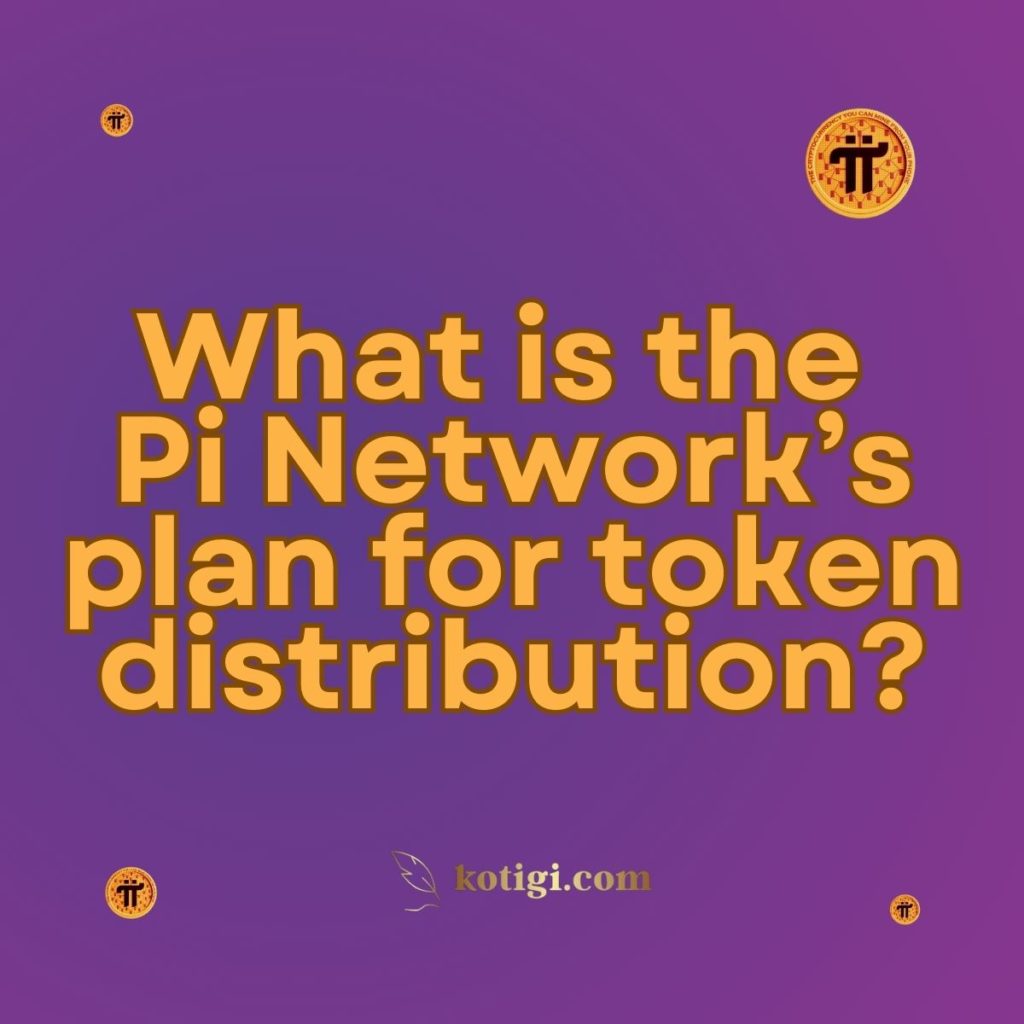
What is the Pi Network’s plan for token distribution?
Pi Network’s token distribution plan aims to create a fair and inclusive cryptocurrency ecosystem.
Pi community has 80% and the Pi Core Team has 20% of the total circulating supply of Pi, regardless of how much circulating supply there is in the Pi Network at any given point in time. Thus, given a total max supply of 100 billion Pi, the community will eventually receive 80 billion Pi and the Core Team will eventually receive 20 billion Pi.
Pi Network’s liquidity pool, consisting of 5 billion Pi tokens, is a critical element in supporting the long-term growth and stability of the Pi ecosystem.
The distribution is designed to reward early adopters, secure the network, and encourage long-term engagement. Pi coins are earned through mobile mining, community contributions, and node participation. As the network transitions to its mainnet phase, Pi will be allocated for in-app transactions, ecosystem development, and decentralized applications (dApps), ensuring a balanced and sustainable economy.
Introduction
Token distribution plays a critical role in the success and fairness of any cryptocurrency project. Pi Network, a unique mobile-first cryptocurrency, has developed a token distribution plan that prioritizes inclusivity, security, and long-term growth. With millions of users already mining Pi on their mobile devices, the platform’s approach ensures that its coins are distributed in a way that rewards participants while also securing the network and fostering future development.
This article delves into the Pi Network’s token distribution plan, explaining how coins are earned, how they will be allocated in the future, and what this means for the overall health and sustainability of the network.
Pi Network Community Allocation
The supply distribution will honor the original distribution principle in the March 14, 2019 Whitepaper—the Pi community has 80% and the Pi Core Team has 20% of the total circulating supply of Pi, regardless of how much circulating supply there is in the Pi Network at any given point in time. Thus, given a total max supply of 100 billion Pi, the community will eventually receive 80 billion Pi and the Core Team will eventually receive 20 billion Pi.
The 80% of the community supply is further divided into:
- 65% allocated for all past and future Pioneer mining rewards, at address GBQQRIQKS7XLMWTTRM2EPMTRLPUGQJDLEKCGNDIFGTBZG4GL5CHHJI25 on the Mainnet,
- 10% reserved for supporting community organization and ecosystem building that will eventually be managed by a Pi Foundation, a non-profit organization in the future, at address GDPDSLFVGEPX6FJKGZXSTJCPTSKKAI4KBHBAQCCKQDXISW3S5SJ6MGMS, and
- 5% reserved for the liquidity pool to provide liquidity for Pioneers and developers in the Pi ecosystem at address GB7HLN74IIY6PENSHHBBJJXWV6IZQDELTBZNXXORDGTL75O4KC5CUXEV.
The following table depicts the community supply distribution:

65 Billion Pi will be allocated for all mining rewards—both past and future mining. For past mining rewards, the rough sum of all Pi mined by all Pioneers so far (before Mainnet) is about 30 Billion Pi. However, after prohibiting the migration of the Pi in fake accounts and depending on the speed and participation of KYC, the pre-Mainnet mined Pi at the beginning of the Open Network can be estimated to range from 10 to 20 Billion. The remaining amount in the 65 billion Pi supply for mining rewards will be distributed to Pioneers through the new Mainnet mining mechanism with conceptual yearly supply limits.
Pi Coin Mining and Rewards
Mobile Mining and User Participation
Pi Network’s primary method of token distribution is through mobile mining, where users earn Pi coins simply by logging into the app daily and pressing the mining button. Unlike traditional mining, which requires expensive hardware and consumes large amounts of energy, Pi mining is lightweight and accessible to anyone with a smartphone. This method of distribution ensures widespread participation across the globe.
Mining Rates and Halving
As an incentive for early adopters, Pi Network’s mining rate has decreased over time. The mining rate is halved periodically based on user milestones, meaning that the earlier a user joins the platform, the more Pi they can mine. This halving mechanism is designed to control the supply of Pi and maintain scarcity as the network grows, similar to Bitcoin’s halving system.
Referral Bonuses and Security Circles
Pi Network encourages users to build security circles—groups of trusted individuals who verify transactions and help secure the network. By creating these security circles and referring new users, participants can increase their mining rate and earn additional Pi. This distribution strategy fosters network growth while ensuring a trusted and secure environment.
Token Allocation Post-Mainnet Launch
Allocating Tokens for Transactions
Once Pi Network transitions to its mainnet phase, a portion of the tokens will be reserved for transactions within the Pi ecosystem. Users will be able to exchange Pi for goods and services, participate in decentralized applications (dApps), and trade Pi coins with others. This allocation ensures that Pi will be usable for real-world purposes, increasing its utility and value over time.
Developer and Ecosystem Support
To support the growth of Pi’s decentralized ecosystem, a significant portion of the tokens will be allocated to developers and projects that build on the platform. This includes funding for dApps, community projects, and other initiatives that enhance Pi’s utility and adoption. By incentivizing developers to contribute, Pi Network aims to create a thriving ecosystem that benefits all participants.
Staking and Validator Rewards
In addition to mobile mining, Pi Network plans to reward users who take on roles as validators or node operators. These participants help secure the network by validating transactions and ensuring the integrity of the blockchain. Validators will be incentivized with additional Pi rewards, encouraging users to maintain the decentralized nature of the platform.
Distribution for Community Growth and Security
Rewarding Early Adopters
Pi Network’s token distribution model rewards early adopters with a higher mining rate. This ensures that those who contributed to the platform’s initial growth receive more Pi coins as a reward for their engagement. As the network matures, mining rates decrease, making Pi harder to earn, which increases the value of tokens held by long-time users.
Building a Trusted Network
The security circle mechanism plays a crucial role in Pi’s distribution plan. By encouraging users to build security circles with trusted individuals, Pi Network ensures that the platform remains secure and reliable. Users are rewarded with additional Pi for building and maintaining these circles, aligning incentives with the network’s security needs.
Scaling Distribution as the Network Grows
Pi Network’s token distribution is designed to scale with user growth. As more people join the platform, the supply of newly mined Pi decreases, ensuring that the token remains scarce and valuable. This controlled distribution model prevents inflation while rewarding early and active participants.
Pi’s Deflationary Mechanism and Long-Term Supply
Controlled Supply and Inflation Prevention
Unlike some cryptocurrencies with unlimited token supplies, Pi Network has a controlled supply model. By gradually reducing the mining rate and capping the total number of Pi coins in circulation, the network avoids inflation and ensures that tokens remain valuable in the long term. This deflationary mechanism is essential for maintaining the token’s scarcity and utility as the ecosystem expands.
Burn Mechanism for Unused Tokens
Pi Network has plans to implement a burn mechanism for unused or inactive tokens. This means that tokens that are not used or transferred within a certain period may be removed from circulation, further reducing the supply of Pi and increasing its scarcity. This approach incentivizes active participation and long-term engagement with the platform.
Token Cap and Future Supply Adjustments
While Pi Network has not officially announced a hard cap on its token supply, the gradual reduction in mining rates and potential burn mechanisms suggest that the supply will be carefully managed. Future adjustments to the distribution plan will likely be made to ensure the token’s value remains stable and sustainable as the network grows.
Incentives for Developers and dApp Creators
Supporting Decentralized Applications (dApps)
A significant portion of Pi’s token distribution is reserved for developers building decentralized applications on the Pi platform. By incentivizing developers to create useful, innovative dApps, Pi Network aims to foster a vibrant ecosystem of decentralized services. These applications will drive adoption and provide real-world use cases for Pi coins.
Funding for Ecosystem Growth
In addition to rewarding individual developers, Pi Network plans to allocate tokens for the overall growth of its ecosystem. This includes funding for community projects, partnerships with businesses, and initiatives that promote Pi’s utility in various industries. These tokens will be distributed based on the impact and value that projects bring to the Pi ecosystem.
Encouraging Innovation Through Grants
Pi Network is also expected to offer grants or rewards to developers who create groundbreaking solutions that enhance the network’s functionality. This encourages ongoing innovation and ensures that Pi remains at the forefront of decentralized technologies.
Validator and Node Operator Incentives
Running a Pi Node
Users who run Pi nodes will play a crucial role in validating transactions and securing the network. Node operators will be rewarded with Pi coins for their efforts, ensuring that the network remains decentralized and robust. Running a node will become increasingly important as Pi transitions to its mainnet phase, where decentralized validation will be key to its success.
Incentivizing Validators
Validators, who help maintain the integrity of Pi’s blockchain by verifying transactions, will also receive a share of the token distribution. These rewards will be allocated to encourage more users to become validators and contribute to the network’s security. This model aligns incentives with the network’s decentralization goals.
Future of Pi Network’s Token Distribution
Transition to Full Decentralization
As Pi Network moves toward full decentralization, its token distribution will continue to evolve. The platform’s goal is to create a self-sustaining economy where tokens are earned through meaningful contributions, whether through mining, node operation, or ecosystem development. This transition will ensure that Pi coins are distributed fairly and sustainably.
Long-Term Sustainability
Pi’s token distribution plan is designed with long-term sustainability in mind. By controlling the supply of tokens, rewarding active participation, and fostering ecosystem growth, Pi Network ensures that its economy remains stable and resilient. This long-term approach benefits both early adopters and new participants, ensuring a fair and balanced distribution of wealth within the network.
Conclusion
Pi Network’s token distribution plan emphasizes fairness, sustainability, and community growth. Through mobile mining, security circles, and ecosystem support, Pi ensures that tokens are distributed to those who contribute to the platform’s success. As the network transitions to its mainnet phase, Pi coins will be allocated for in-app transactions, dApp development, and decentralized validation, creating a balanced and inclusive economy.
Key Takeaways
- Mobile Mining: Pi coins are primarily distributed through energy-efficient mobile mining, ensuring accessibility and widespread participation.
- Halving Mechanism: The mining rate decreases over time, rewarding early adopters with higher Pi earnings.
- Post-Mainnet Distribution: Pi tokens will be allocated for transactions, ecosystem development, and supporting dApps.
- Validator Rewards: Node operators and validators will be incentivized with Pi coins for securing the network.
- Sustainable Token Supply: Pi Network’s distribution plan includes mechanisms to prevent inflation and ensure long-term token value.





